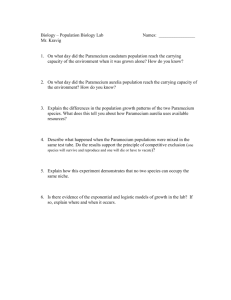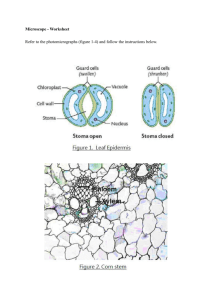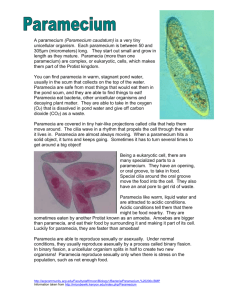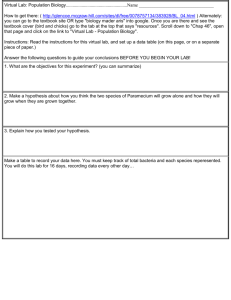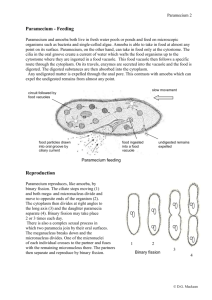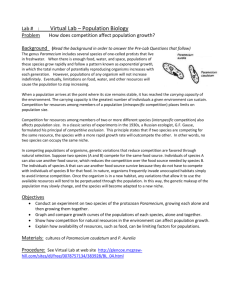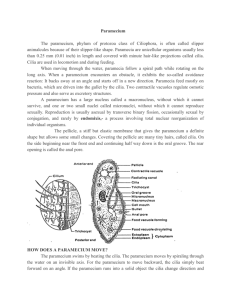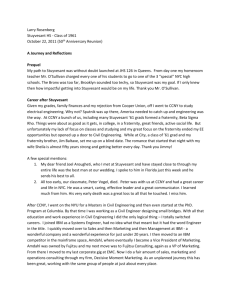NedREVLAB4_REPORT 429 KB
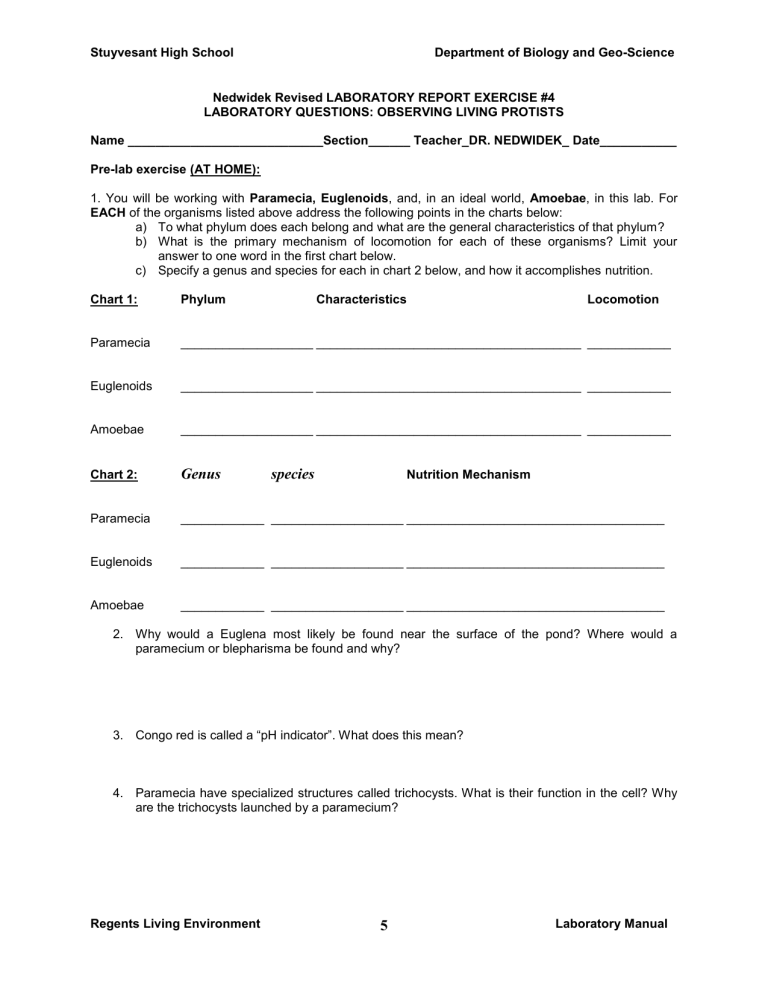
Stuyvesant High School Department of Biology and Geo-Science
Nedwidek Revised LABORATORY REPORT EXERCISE #4
LABORATORY QUESTIONS: OBSERVING LIVING PROTISTS
Name ____________________________Section______ Teacher_DR. NEDWIDEK_ Date___________
Pre-lab exercise (AT HOME):
1. You will be working with Paramecia, Euglenoids , and, in an ideal world, Amoebae , in this lab. For
EACH of the organisms listed above address the following points in the charts below: a) To what phylum does each belong and what are the general characteristics of that phylum? b) What is the primary mechanism of locomotion for each of these organisms? Limit your answer to one word in the first chart below. c) Specify a genus and species for each in chart 2 below, and how it accomplishes nutrition.
Phylum Characteristics Locomotion Chart 1:
Paramecia
Euglenoids
___________________ ______________________________________ ____________
___________________ ______________________________________ ____________
Amoebae ___________________ ______________________________________ ____________
Chart 2:
Genus species
Nutrition Mechanism
Paramecia
Euglenoids
Amoebae
____________ ___________________ _____________________________________
____________ ___________________ _____________________________________
____________ ___________________ _____________________________________
2. Why would a Euglena most likely be found near the surface of the pond? Where would a paramecium or blepharisma be found and why?
3. Congo red is called a “pH indicator”. What does this mean?
4. Paramecia have specialized structures called trichocysts. What is their function in the cell? Why are the trichocysts launched by a paramecium?
Regents Living Environment 5 Laboratory Manual
Stuyvesant High School Department of Biology and Geo-Science
SUMMARY QUESTIONS AND DRAWING GUIDELINES (AT LAB):
1. Use the Drawing Form from this Lab Manual to DRAW IN PENCIL ONLY and name above your drawing TWO of the (non-paramecium) protists you observed under 40x or 100x and specify the magnification underneath each drawing, as well as their es timated sizes in micrometers (μm).
Make sketches which capture their activities, such as their way of moving or eating. LABEL the cell membrane and nucleus for each with a line pointing to the structure , and label any other cellular structures that you can observe.
2. Describe below the motion of each of the above protists you drew as they move in one direction.
3. Use the opposite side of the Drawing Form from this Lab Manual to DRAW IN PENCIL ONLY a sketch of a paramecium under high power (400x) showing several yeast-filled food vacuoles. Label the cell membrane, the nucleus, and the filled vacuoles , indicating magnification underneath .
DRAW a pencil sketch of a paramecium under high power (400x) which has discharged its trichocysts. Label the trichocyst structure and indicate magnification underneath the drawing.
4. How did the paramecium react when it encountered an object?
5. What happens to the color of the Congo red yeast mixture as it is ingested and circulated in the food vacuoles of the paramecium? Why do you think this is happening? Hint: Congo red behaves similarly to litmus.
6. Describe what you saw when you added acidified blue ink to the paramecia to induce trichocyst formation.
Regents Living Environment 6 Laboratory Manual
Stuyvesant High School Department of Biology and Geo-Science
7. Label the following 8 structures in the diagram of the paramecium below (AT HOME) :
Pellicle Contractile Vacuole Macronucleus Cilia
Cytostome (oral groove) Micronucleus Anal Pore Food Vacuole
Closing Declaration: At the close of this lab report, I can attest to having done it by my own hand. If I received help from peers or from tutors in doing it, this was purely to understand the material, and I did not knowingly transfer information from or to other sources (my peers or otherwise) in the process of doing this work.
Student Signature: __________________________ Date: ______________
Lab Completed Satisfactorily___________________________________
Teacher Signature
Regents Living Environment 7 Laboratory Manual

